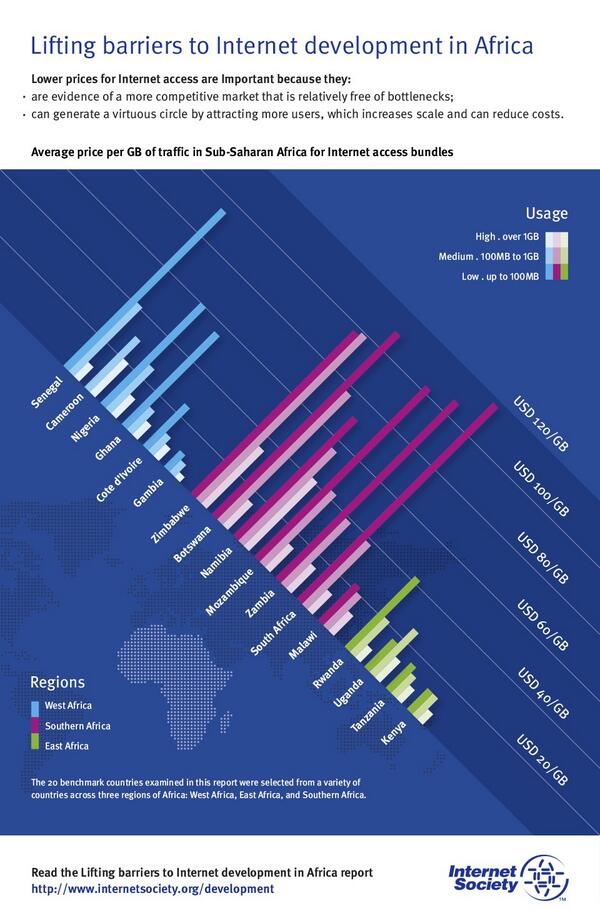Experts gather to strengthen African internet peering and regional interconnection
This week, the Internet Society, with the aid of 16 sponsors, is hosting the 4th Annual African Peering Interconnection Forum, also known as AfPIF 2013. The goal is to create efficient and cost-effective African networks that support private business but also reduce internet costs for consumers.
The event, held in Casablanca, Morocco, is again neatly organized into three days (one for training; two for forums). Day One discussions were heavy on internet peering and the need for internet exchange points. An excellent recap of this ‘Peering Coordinators Day‘ can be found on the Internet Society site. Day Two focused on the role of the public and private sector in developing national and regional interconnection. The final day (Sept. 5) will discuss strategies to develop and share content, along with the nuances of carrier neutral infrastructure.
In the meantime, the ISOC and AfPIF have done a great job summarizing the event.
Presentations from the first two days are already available. Some highlights:
The Euro-IX update cites a few facts about IXPs found in Africa:
- 29 IXPs in the Africa region
- 22 of 54 countries (40%) have an IXP
- 26 cities have at least one IXP
- traffic has grown from 8 Gbps to 88 Gbps over public peering LAN in the past 12 months
Moez Chakchouk, Chairman & CEO of ATI explains Tunisia’s internet revolution, IXP, how to promote cross border interconnection in the region. He also notes the presence of submarine cables in North Africa:
- Mauritania: 1 submarine cable/1 landing station
- Morocco: 5 submarine cables/3 landing stations
- Algeria: 4 submarine cables/4 landing stations
- Tunisia: 4 submarine cables/2 landing stations
- Libya: 3 submarine cables/2 landing stations
A presentation by Michael Kende, Chief Economist of the Internet Society cited a past deck from Analysys Mason:
Submarine Cables:
- USD 3.8 billion invested in recent years
- Added 24 Gbit/s of new capacity on top of 13 Gbit/s prior to 2011
- Seven countries have their first landing station
- 11 other countries have an additional landing station
Terrestrial Capacity:
- USD 8 billion invested
- Nearly 100 route-kilometers of new capacity available each day in Africa
Challenges:
- 16 landlocked countries in Africa that require cross-border terrestrial capacity
- Two coastal countries have no submarine cables, others have only one or two
- Evidence that cross-border connections are still limited, resulting in indirect traffic exchange
Mike Jensen spoke on interconnection policy shortfalls:
- In Southern Africa, a recent Internet Society study found that of the total 47 national boundaries between the mainland countries in the region, only two boundaries have two or more links operated by competing providers.
- Landlocked Rwanda and Uganda exchange traffic in the UK even though the Rwandan link runs through Uganda to get to the submarine cables.
- The ISOC SADC study found that although over 80% of the borders between neighboring mainland countries have fibre links between them, Internet traffic is only exchanged directly in less than 25% of the 132 potential links between the countries.
Mamadou Diallo Iam of Internet Society Mali spoke to the country’s networks. He cited a variety of 2012 statistics from a report from the national telecoms regulator (AMRTP):
- 14,141 localities covered by a mobile signal
- 90% mobile penetration (3% in 2003)
- 58,344 fixed Internet subscribers
- 1,205,886 mobile internet users (200,666 in 2010)
Coppens Ndayiragije relayed information on the upcoming Burundi Internet Exchange Point, BurundiX. The project will allow for a variety of benefits some of which are:
- national backbone length: 1,250km
- all local ISPs interconnected to local IXP
- national datacenter for e-government applications
- local cloud computing, usage of ccTLD .bi for all local public and private institutions
- local caches for global companies
On Twitter, @AfPIF is providing supplemental live coverage of the event. Many points from the aforementioned presentations were mentioned, but a few others were also shared.
Highlights from the official AfPIF Twitter account include:
- 167 million of the 1 billion people in Africa have access to internet
- Algeria has 30 ISPs, 3 mobile operators with one land line operator and 100% teledensity- comparing wireless, mobile and landline
- Bangui in Central Africa Rep and Asmara are the two capital cities in Africa yet to be connected with Fiber optic cables
- Morocco has 2 million Internet users, in the process of awarding a 4G license, to increase the numbers and .ma domain name has 64,000 domain but most of the content is hosted overseas because of higher hosting costs
A live webcast can be found starting at 8am GMT. Presentations from Day Three will be posted online at the close of the day.














 Twitter
Twitter Facebook
Facebook Pinterest
Pinterest